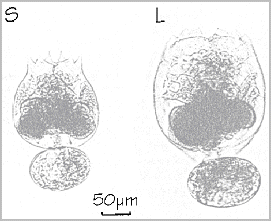4. Strain Differences
Only a few rotifer species belonging to the genus Brachionus are
used in aquaculture. As outlined in the introduction the most widely used
species is Brachionus plicatilis, a cosmopolitan inhabitant of inland
saline and coastal brackish waters. It has a lorica length of 100 to 340
µm, the lorica ends with 6 occipital spines (Fukusho,
1989).
For use in aquaculture, however, a simple classification is used which is
based on two different morphotypes. People distinguish: Brachionus
rotundiformis or small (S-type) rotifers and Brachionus plicatilis
or large (L-type) rotifers. The differences among the two types can clearly be
distinguished by morphological characteristics: the lorica length of the L-type
is 130 to 340 mm (average 239 µm), of the S-type 100 to 210 µm
(average 160 µm). Moreover, the lorica of the S-type shows pointed spines,
while the L-type has obtuse angled spines (Fig. 3.3.).

Figure 3.3. Brachionus rotundiformis (S-type) and Brachionus plicatilis (L-type) (modified from Fu et al. , 1991).
In tropical aquaculture
the SS-type rotifers (Super small rotifers) are preferred for the first feeding
of fish larvae with small mouth openings (rabbitfish, groupers, and other fish
with mouth openings at start feeding of less than 100 µm). Those rotifers,
however, are genetically not isolated from S-strains, but are smaller than
common S-strains.
The S- and L- morphotypes also differ in their optimal growth
temperature. The S-type has an optimal growth at 28-35 °C, while the
L-type reaches its optimal growth at 22-28 °C. Since contamination with
both types of rotifers occurs frequently, lowering or increasing culture
temperatures can be used to obtain pure cultures: rotifers at their upper or
lower tolerance limit do not multiply as fast and can in this way be
out-competed in favour of the desired morphotype.
It should be emphasized that, besides intraspecific size variations,
important interspecific variation in size can occur as a function of salinity
level or dietary regime. This polymorphism can result in a difference of
maximal 15% (Fukusho and
Iwamoto, 1981). Rotifers fed on baker's yeast are usually larger
than those fed on live algae.
1.
Introduction
2. Morphology
3. Biology and Life History
4. Strain Differences
5. General Culture Procedures